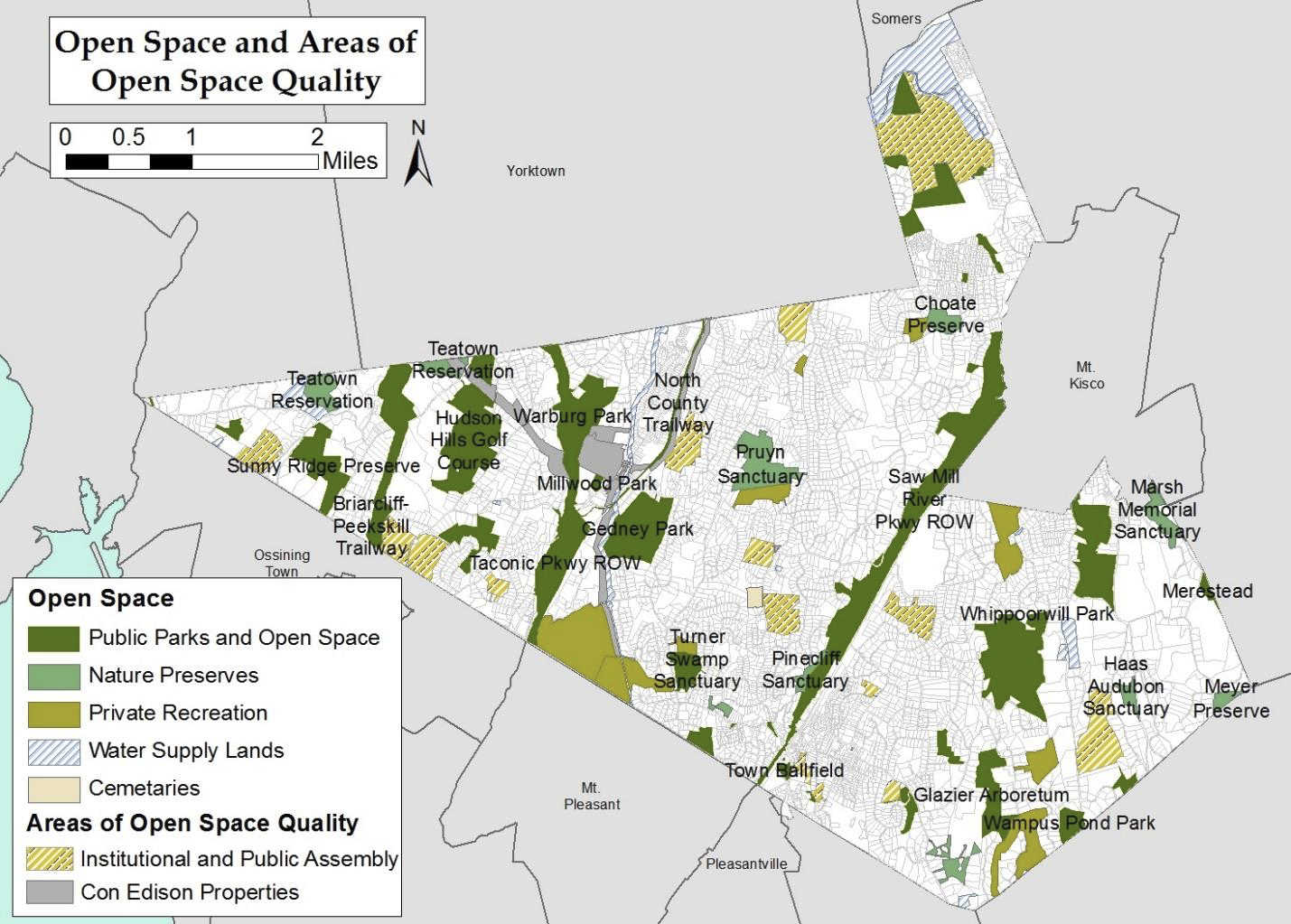Open Space and Natural Features
Harmony with Nature:
Open Space and Natural Features
As discussed in Chapter 1, Livable Built Environment, the Town’s most visible environmental asset is its bucolic character. The Town’s natural setting has been preserved through careful land use planning, environmental conservation and the designation of open space lands. New Castle’s open spaces and areas of open space character (due to large industrial properties and large residential properties) provide immense benefits to the community. They support natural ecosystems and serve as a habitat for the region’s biodiverse animal and plant populations. They provide settings for residents to interact with the natural environment, to gather, and to engage in both passive and active recreation. Lastly, they shape the Town’s natural, peaceful and pristine character. It is important that open spaces are protected and managed so that they continue to provide these benefits.
Of the Town’s 15,000 acres, approximately 4,418 can be categorized as open space according to the New York State Department of Environmental Conservation (NYSDEC). The NYSDEC’s definition of open space includes agricultural lands; cemeteries; local, County and State parks and parkway lands; nature preserves; private recreation; vacant or undeveloped lands; and water supply lands. Large lots that exist among New Castle’s low-density residential areas that are not included in the DEC’s definition of open space, such as school campuses, Con Edison lands and other institutional properties, also contribute significantly towards the Town’s bucolic open space character. These lands were the subject of much discussion in the TDP, as it was recognized that it was critical to maintain the open space character of these lands in order to preserve that of the Town. This Plan carries forth this idea and recommends that the Town’s Open Space Management Plan be updated not only to maintain established open spaces, but also to maintain the character of lands that provide open space benefits but are not officially defined or designated as such.

New Castle’s landscape is rich in environmental resources. There are twenty-one New York State designated wetlands dispersed throughout the Town, which span a total of 849 acres. Other, smaller wetlands have been identified and mapped as part of the National Wetland
The Town’s topography ranges from a low of approximately 190 feet above sea level to a high of approximately 770 feet above sea level. About 39% of the land in New Castle (5,799 acres) contains steep slopes. Of these areas, 3,660 acres have slopes of 15 – 25% and 2,139 acres have slopes greater than 25%. The most significant concentrations of steep slopes are located on the west end of Town. The preservation of the natural vegetation on these slopes has become increasingly important for the purposes of limiting erosion and flooding.
The Town’s topographic and environmental features serve as a habitat for a range of flora and fauna, many of which are part of a unique ecosystem referred to as seasonal forest pools or woodland vernal pools. A wide variety of amphibians thrive in these seasonal forest pools and wetland ecosystems. The Town’s species include deer, coyotes, Cooper’s Hawk, Sharp-Shinned Hawk, and various fish species such as bass, trout, bluegill, and crappie. The New York State Department of Environmental Conservation (NYS DEC) and the United States Fish and Wildlife Service maintain lists of threatened and endangered species, some of which may be found within the Town’s borders .These biodiverse species rely on the health of the Town’s natural landscape, while the upkeep of the landscape itself depends on the survival of the species that make it their home. The Town of New Castle recognizes the value of our natural environment and the fact that it is not wholly within the Town’s control. As can be seen through various regional studies, natural systems do not follow municipal boundaries. As an example, in 2004, the Metropolitan Conservation Alliance produced the Croton-to-Highlands Biodiversity Plan (CHBP) to promote the conservation of the rich biodiversity of natural habitats and wildlife found in northern Westchester. A portion of New Castle’s west end was included within the CHBP. A Town-wide biodiversity plan has yet to be developed in New Castle. This Plan recommends the development of a Town-wide Biodiversity Management Plan that includes among other things, identification of invasive species and their impacts as well as a Natural Resource Index to aid in a more systematic approach to the preservation and support of the Town’s natural ecosystems and habitats.